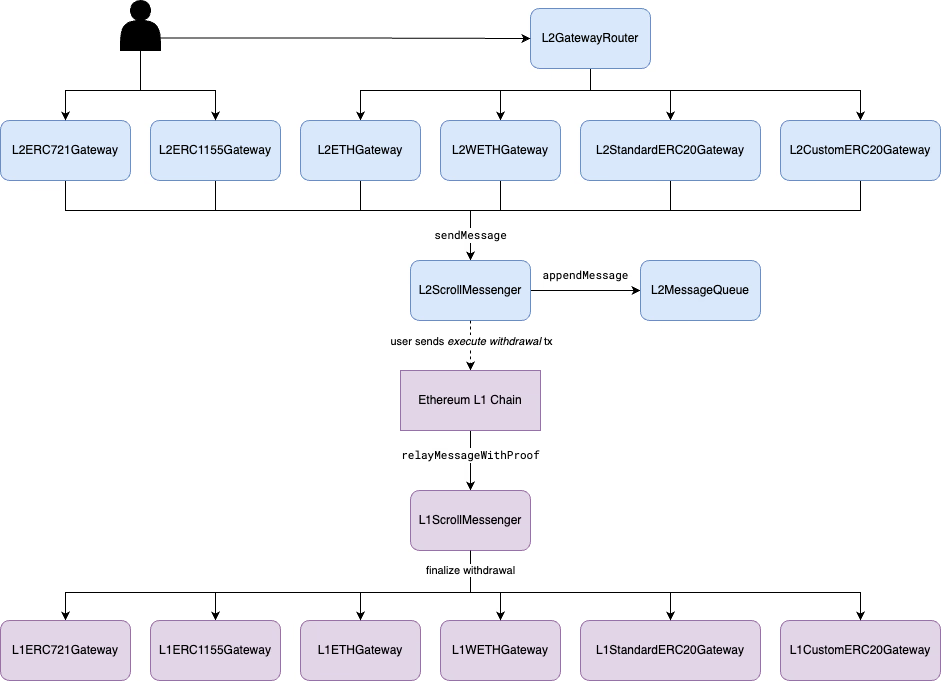Withdraw Gateways
This document describes how users and developers can utilize gateways to withdraw tokens from L2 to L1. We provide several gateways for standard tokens and a gateway router on L2, listed in the table below.
| Gateway Contract | Description |
|---|---|
L2GatewayRouter | The gateway router supports the withdrawal of ETH and ERC20 tokens. |
L2ETHGateway | The gateway for ETH withdrawals. |
L2StandardERC20Gateway | The gateway for standard ERC20 token withdrawals. |
L2CustomERC20Gateway | The gateway for custom ERC20 token withdrawals. |
L2WETHGateway | The gateway for Wrapped ETH withdrawals. |
L2ERC721Gateway | The gateway for ERC-721 token withdrawals. |
L2ERC1155Gateway | The gateway for ERC-1155 token withdrawals. |
Overview

The figure depicts the withdrawal workflow from L2 to L1. Users call the gateways to initialize the token withdrawal. The withdrawal is encoded into a message sent to the L2ScrollMessenger, which is then appended to the L2MessageQueue. L2MessageQueue maintains a Withdraw Trie and updates the root every time a new message is appended. The Withdraw Trie root is finalized on the L1 rollup contract along with the L2 state root. After the new Withdraw Trie root is finalized on the L1, users or third parties can then construct a valid Merkle Inclusion Proof to the Withdraw Trie root and send a withdraw execution transaction to finalize the withdrawal on L1. You can find more details about the L2-to-L1 message relay workflow in the Cross-Domain Messaging.
The subsequent sections describe the details of how different tokens are withdrawn.
Withdrawing ETH
The withdrawal of ETH token works as follows.
-
L2GatewayRouterprovides three functions to withdraw ETH from L2 to L1.withdrawETHAndCallfunction can withdraw ETH and execute a contract call at the same time.function withdrawETH(uint256 _amount, uint256 _gasLimit) external payable;function withdrawETH(address _to, uint256 _amount, uint256 _gasLimit) public payable;function withdrawETHAndCall(address _to,uint256 _amount,bytes calldata _data,uint256 _gasLimit) external payable; -
The
withdrawETHAndCallfunctions call intoL2ETHGateway.L2ETHGatewayencodes the withdraw message and sends it to theL2ScrollMessengercontract along with the withdrawn ETH. -
The withdrawn ETH is again locked in the
L2ScrollMessengercontract.L2ScrollMessengerappends the message to the message queue in theL2MessageQueuecontract. -
The withdrawal execution transaction on L1 calls the
L1ScrollMessenger.relayMessageWithProoffunction to finalize the withdrawal. In the case of ETH withdrawal, therelayMessageWithProoffunction callsL1ETHGateway.finalizeWithdrawETHto send back ETH to the recipient account on L1. -
If the user calls
withdrawETHAndCallon L2, thefinalizeWithdrawETHin theL1ETHGatewaycontract will forward the additional data to the target L1 contract.
Withdrawing ERC20 Tokens
The withdrawal of ERC20 tokens works as follows.
-
To withdraw ERC20 tokens from L2 to L1, users can use
L2GatewayRouter.withdrawERC20andL2GatewayRouter.withdrawERC20AndCallshowed below.function withdrawERC20(address _token, uint256 _amount, uint256 _gasLimit) external payable;function withdrawERC20(address _token, address _to, uint256 _amount, uint256 _gasLimit) external payable;function withdrawERC20AndCall(address _token,address _to,uint256 _amount,bytes memory _data,uint256 _gasLimit) public payable; -
Based on the mapping from ERC20 tokens to gateway, the
L2GatewayRoutercalls to the corresponding gateway,L2StandardERC20Gateway,L2CustomERC20Gateway, orL2WETHGateway. The remaining steps will be described separately.
Standard and Custom ERC20 Tokens
The withdrawal of standard and custom ERC20 tokens works in the same way as follows.
- The
L2StandardERC20GatewayorL2CustomERC20Gatewaycontract burns the withdrawn ERC20 token, encodes the withdrawal into a message, and sends it toL2ScrollMessenger. - The L1 withdrawal execution transaction calls
L1ScrollMessenger.relayMessageWithProoffunction to finalize the withdrawals on L1. In the case of standard or custom ERC20 token withdrawal, the transaction callsfinalizeWithdrawERC20function on theL1StandardERC20GatewayorL1CustomERC20Gatewaycontract respectively.- In the
L1StandardERC20Gatewaycontract, if this is the first withdrawal transaction of an ERC20 token,finalizeWithdrawERC20function will update the mapping from L1 token address to its L2 token address in thetokenMapping.
- In the
- The L1 ERC20 token gateway releases the locked ERC20 tokens by transferring them from itself to the recipient address on L1.
- If the user calls
withdrawERC20AndCallon L2, the gateways will call the target L1 contract with additional data.
WETH Token
We provide a custom gateway L2WETHGateway for Wrapped ETH token on L2 and record the gateway address in the L2GatewayRouter. The withdrawal of WETH token works as follows.
L2WETHGatewaytransfers the withdrawn WETH token to itself and unwraps WETH token to native ETH token. The ETH token is then sent back to theL2ScrollMessengercontract.L2WETHGatewayencodes the token withdrawal message and forwards it toL2ScrollMessenger.- The L1 withdrawal execution transaction calls
L1ScrollMessenger.relayMessageWithProoffunction to finalize the withdrawal on L1. In the case of WETH token withdrawal, the transaction callsL1WETHGateway.finalizeWithdrawERC20and sends the withdrawn amount in ETH toL1WETHGateway. L1WETHGatewaywraps the withdrawn ETH to L1 WETH token again and transfers to the recipient address on L1.- If the user calls
withdrawERC20AndCallon L2, theL1WETHGatewaywill call the target L1 address with additional data.
Withdrawing ERC-721/ERC-1155 Tokens
The withdrawal of ERC-721 or ERC-1155 tokens works very similar to ERC20 tokens. One can use the gateway L2ERC721Gateway or L2ERC1155Gateway to withdraw ERC-721 /ERC-1155 tokens from L2.
function withdrawERC721( address _token, uint256 _tokenId, uint256 _gasLimit) external payable;
function withdrawERC721( address _token, address _to, uint256 _tokenId, uint256 _gasLimit) external payable;
function withdrawERC1155( address _token, uint256 _tokenId, uint256 _amount, uint256 _gasLimit) external payable;
function withdrawERC1155( address _token, address _to, uint256 _tokenId, uint256 _amount, uint256 _gasLimit) external payable;To facilitate a large amount of ERC-721 or ERC-1155 token withdrawals, we also provide batch withdraw functions in the L2ERC721Gateway and L2ERC1155Gateway contract via the following functions:
function batchWithdrawERC721( address _token, uint256[] calldata _tokenIds, uint256 _gasLimit) external payable;
function batchWithdrawERC721( address _token, address _to, uint256[] calldata _tokenIds, uint256 _gasLimit) external payable;
function batchWithdrawERC1155( address _token, uint256[] calldata _tokenIds, uint256[] calldata _amounts, uint256 _gasLimit) external payable;
function batchWithdrawERC1155( address _token, address _to, uint256[] calldata _tokenIds, uint256[] calldata _amounts, uint256 _gasLimit) external payable;The L1 counterpart contracts for ERC-721 or ERC-1155 tokens are L1ERC721Gateway and L1ERC1155Gateway to finalize withdrawals on L1.